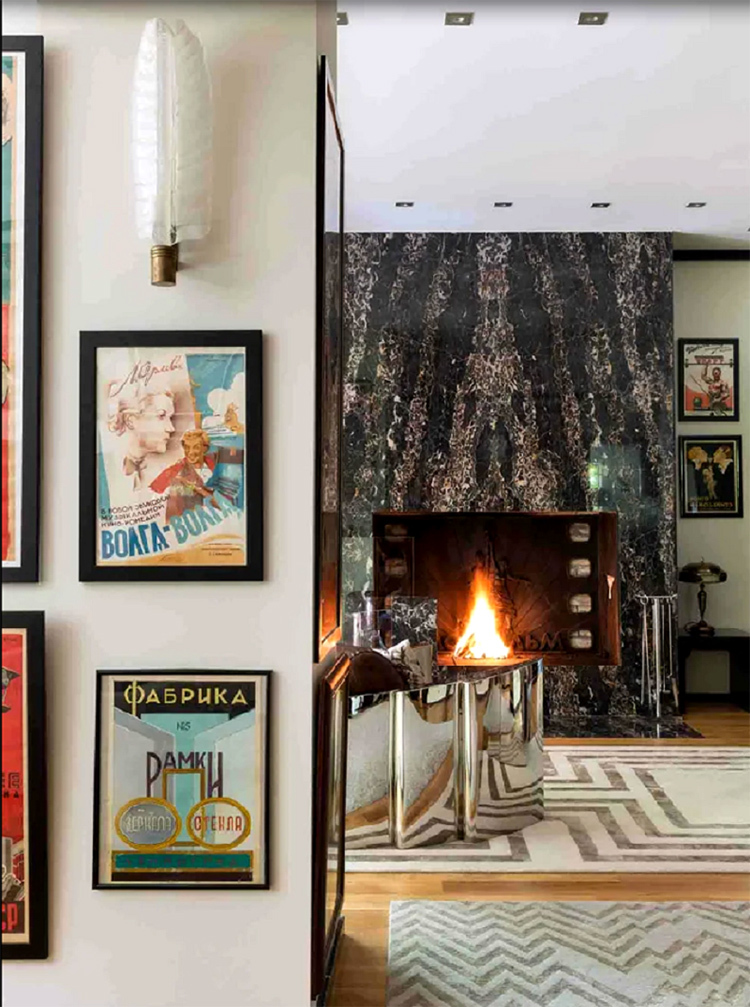When creating a garden design, not only professionals, but also amateur gardeners are increasingly turning to the oriental style of growing miniature trees in pots or open ground. Numerous techniques of a promising direction make it possible to obtain a plant of any configuration. However, the formation of a garden bonsai or nivaki has some differences from the classical one, combining standard tree care work.
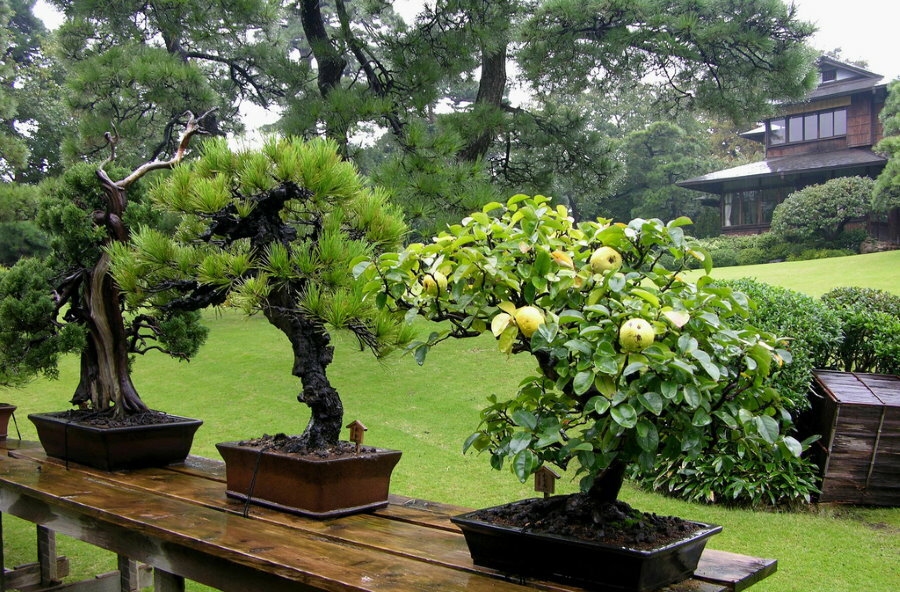
The art of bonsai is a whole science with numerous schools and techniques for forming plants in various configurations.
Garden bonsai in landscape design
Content
- Garden bonsai in landscape design
- Bonsai shapes - styles
- Fan style (hokidachi)
- Formal vertical style (tekkan)
- Informal vertical style (moegi)
- Oblique bonsai style (shakan)
- Cascading style (kengai)
- Wind-bent tree (fukinagashi)
- Dead wood style (sharimiki)
- What plants can you make a bonsai
- White japanese pine
- Scots pine
- Mountain pine
- Black pine bonsai
- Conclusion
- Video: How to create a bansai at your dacha from a common pine
- Photo: Bansai in the garden landscape
A distinctive feature of a Japanese-style garden is water, stones, flowering shrubs and bonsai-style plants, literally translated as "a tree in a bowl." Japanese mini trees are formed by natural growth patterns. They are grown in the open field, the tree can be of any size, and with the help of special tools it is given the features characteristic of a real bonsai.
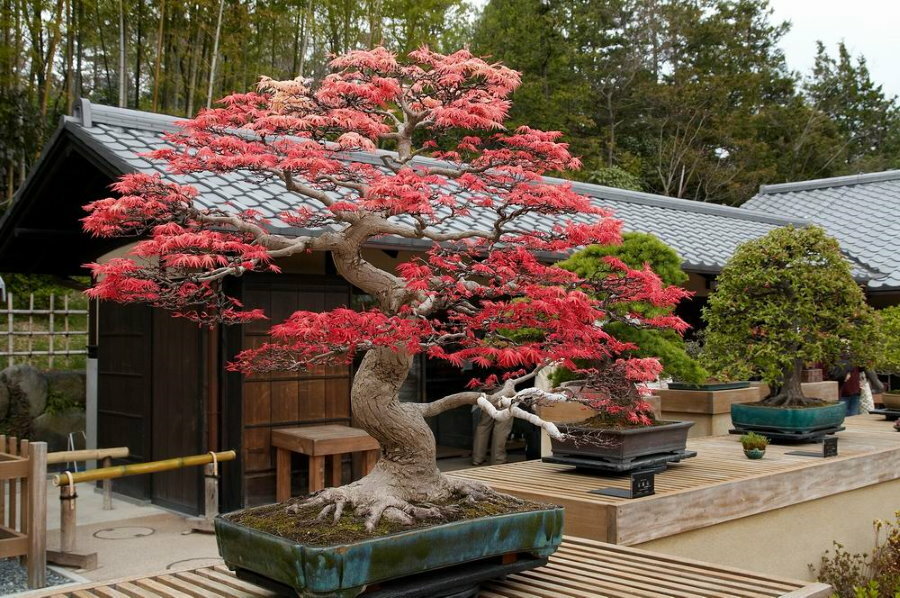
The size of the garden bonsai, unlike the traditional one, can be arbitrary.
The Japanese technique for creating decorative bonsai trees is a laborious process. The desired shape is acquired after many years. In landscape plantings, imitation of weather phenomena is most common, the idea of which was suggested by nature itself. The look of aged bark, twisted trunk or thinned branches give the visual impression of a mature tree, which is an interesting nuance for a garden bonsai. Even a young Japanese-style plant can look like it is 50 years old.
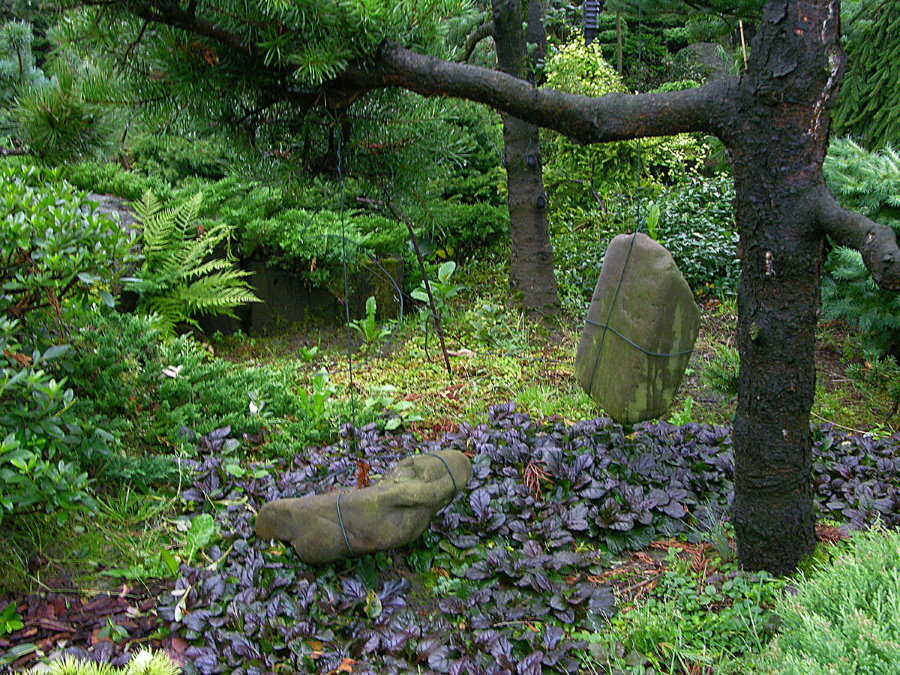
It takes years to form the crown, sometimes you have to fix the branches with the help of weights
Miniature Japanese trees are used both in group planting and in a stand-alone form. The shape of the crown can be different, in the form of plates, balls or clouds. When creating a garden bonsai, do not forget that this is not only a formed tree. First of all, it must harmoniously fit into the surrounding space. To maintain the oriental style, everything is cut in the garden. Any shrub or plant similar in appearance to the Japanese flora will be a great addition to beautiful trees.
Japanese-style gardens have a certain meaning. An ideal place for planting a beautiful plant - in plain sight, with a minimum of decorative elements.
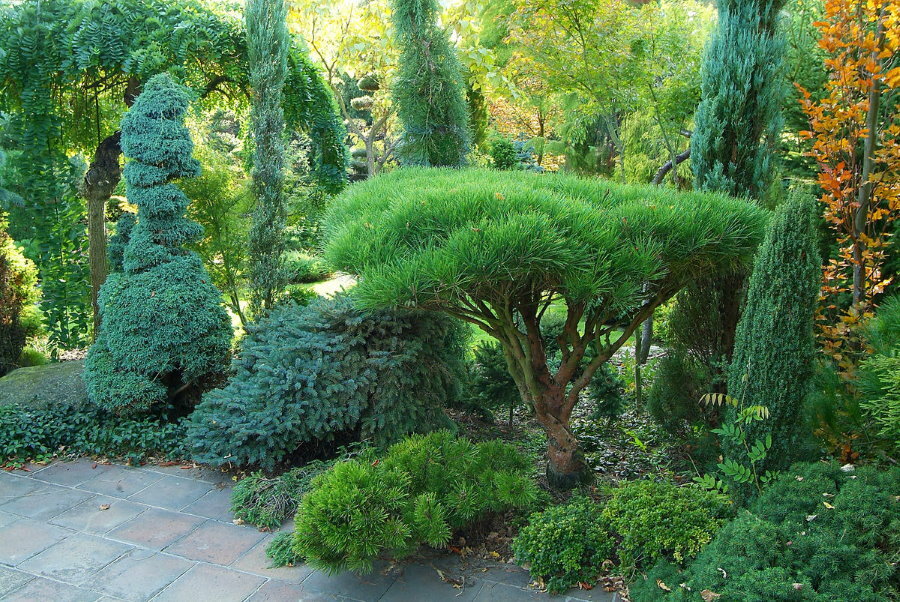
It takes a long time to create a bonsai, but it gives very impressive results.
A properly formed tree will harmoniously fit not only into the garden, but also into the gazebo or terrace made in the European style. As a form of topiary art, bonsai looks great in geometrically designed gardens. It goes well with the clean design, manicured lawns and quiet ponds.
The decorative appearance of the nivaki and its compliance with the chosen style depend on proper care.
Bonsai shapes - styles
The styles that define the basis for the classification of bonsai are reminiscent of the shapes of trees in the surrounding nature. Through individual creativity, they can transform.
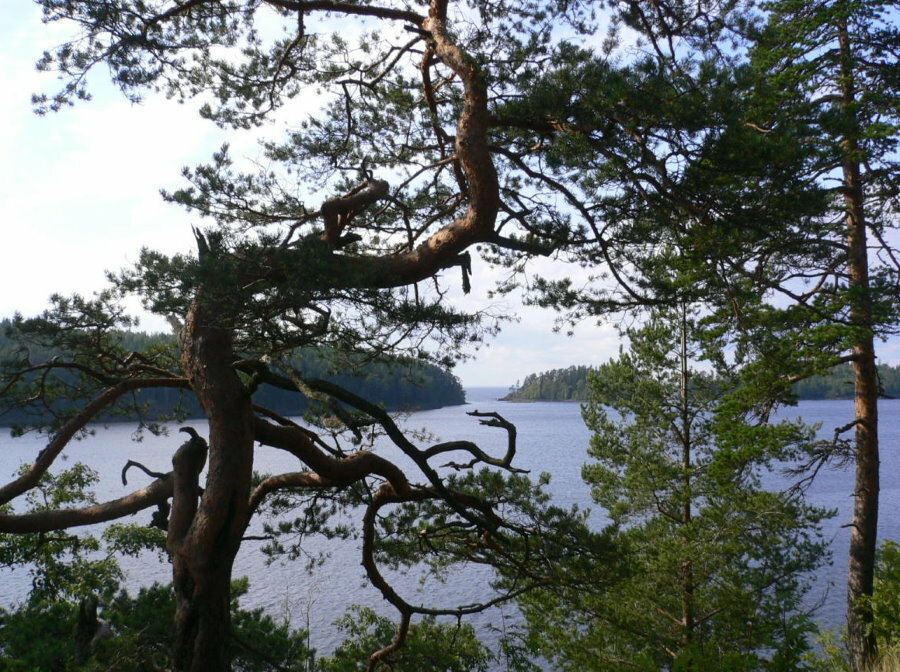
Bonsai, created by nature itself
Fan style (hokidachi)
The fan style, which has another name for the broom, is relevant for deciduous representatives of woody plants. The basic principle of the style is erect. The stiff stalk is always erect and erect, but does not reach the crown of the tree, branching in different directions. It is located at a distance ⅓ of the total plant height. Numerous branches and a small size of the trunk, reminiscent of a graphic drawing, look impressive even during leaf fall. An elm or maple is better suited as the basis for the embodiment of such a tree.
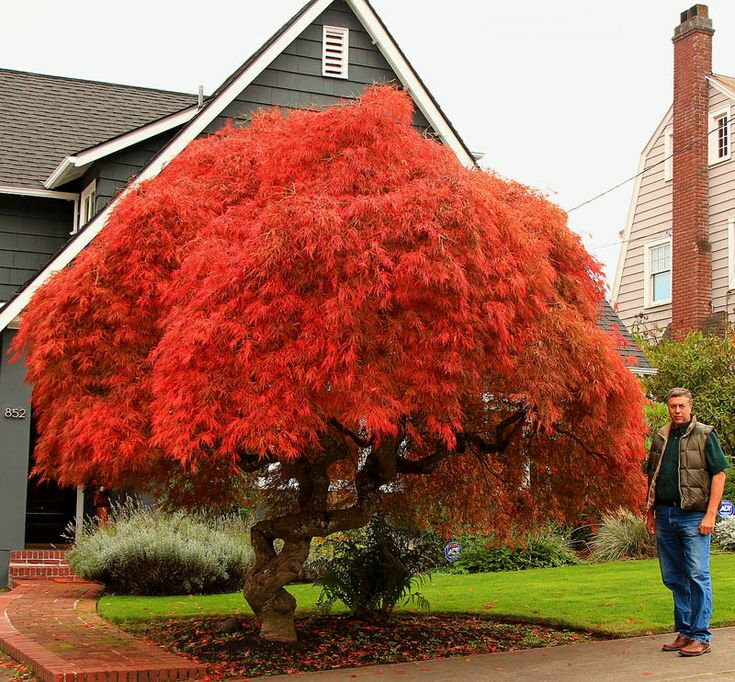
Red Japanese maple is most commonly used for fan style.
Formal vertical style (tekkan)
A characteristic feature of one of the most common styles is the gradual narrowing of the trunk diameter from the base to the crown. This form of trees is often found in sunny growing conditions, where the excess of light eliminates competition with other plants. Forking should appear at a distance of ¼ from the entire height of the tree. As simple and clear as possible, the lines create a paramount and important shape that every bonsai connoisseur should be familiar with.
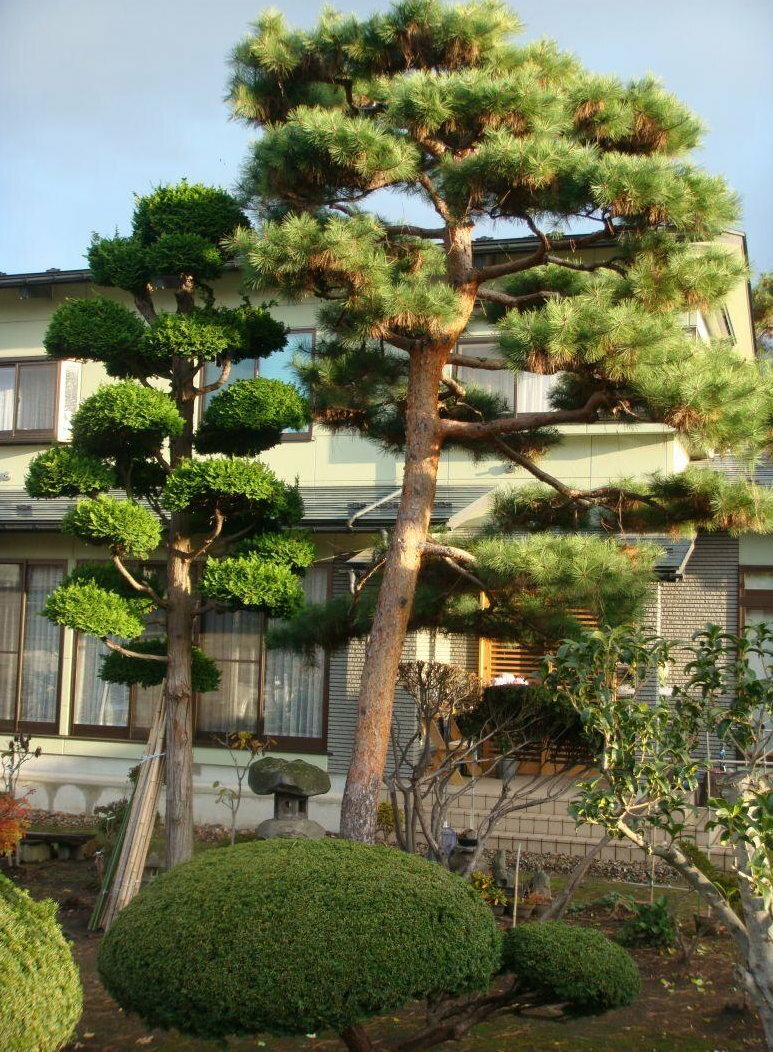
Formal vertical style is quite common in bonsai.
Informal vertical style (moegi)
The popular style is characterized by a curved vertical trunk line and a pronounced kink at the base. Ideally, the number of bends does not exceed three, with the same angle of inclination in relation to each other.
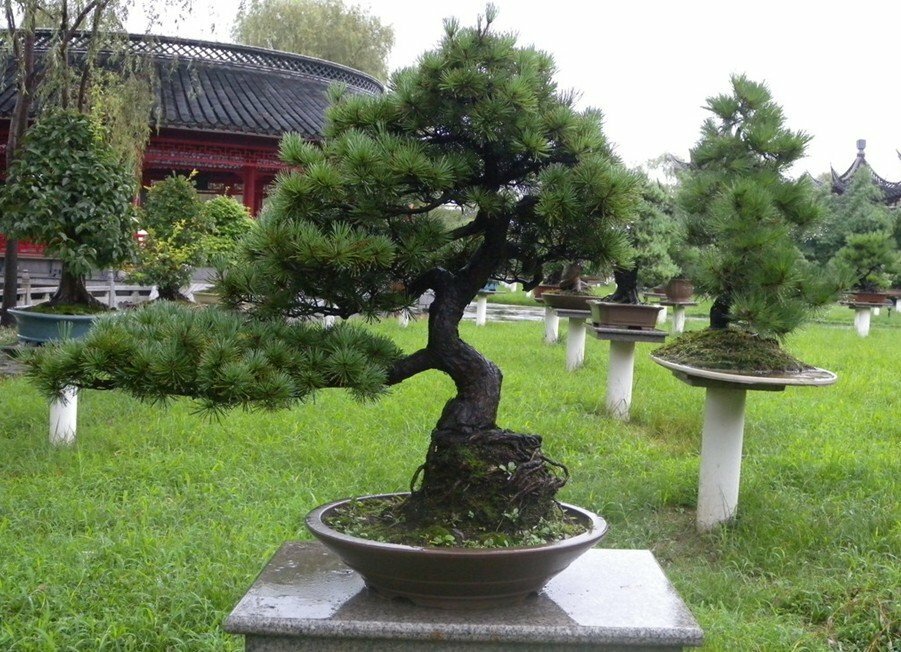
Externally, the tree trunk should resemble the English letter S
The main features of the style:
- curved trunk with good tapering;
- the location of the base of the tree and its crown on the same vertical with a strict upward direction;
- the ratio of the bare trunk to the shape is ¼.
Conifers (juniper, pine) and hardwood (maple, oak) are better suited for this style.
A tree with sparsely located branches on the bends of the trunk looks attractive.
Oblique bonsai style (shakan)
Styling assumes tree growth at an angle of 60-80 °. The trunk can be narrow or thick, straight or curved, with branches growing on two sides. Strengthen the effect of the tree upturned by the wind by the roots peeking out of the ground. To visually balance the composition, the first branch should grow in the opposite direction to the slope.
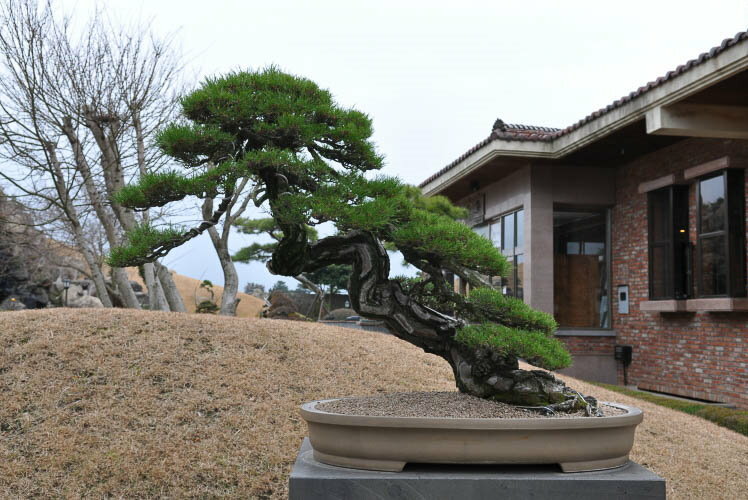
Under natural conditions, this tree shape can occur if the winds blow predominantly in one direction or when the plant is forced to stretch from the shadow to the sun.
Cascading style (kengai)
Naturally, a tree can bend under the weight of snow, stones, or other factors. It is not easy to keep this direction in an artificial design. Typically, the cascading style involves planting trees in tall pots.
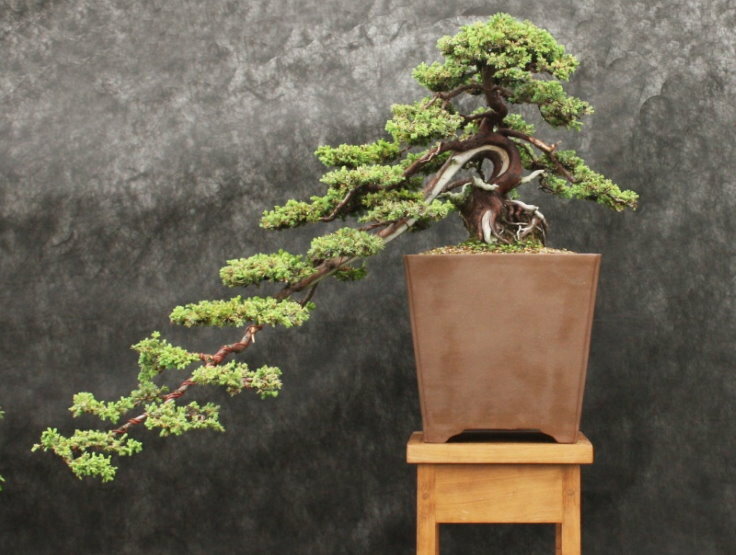
The main branch of a cascade-style plant should fall below the bottom of the pot.
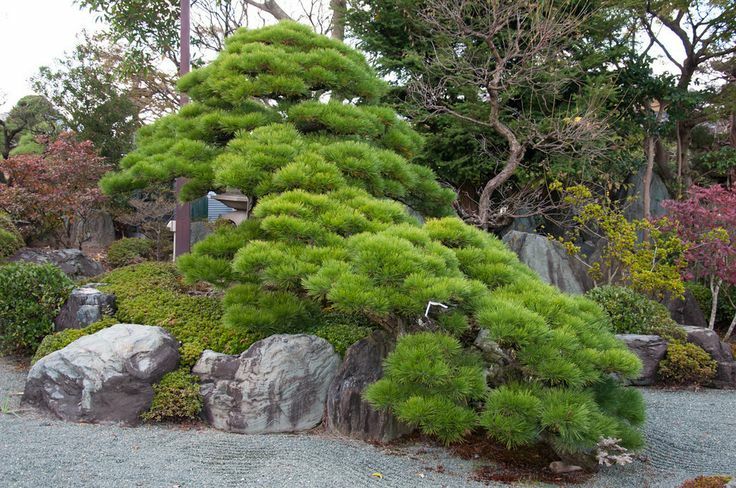
When grown outdoors, a semi-cascade style is used, in which the last cascade should not fall below the root system of the plant.
Character traits:
- vertical base with gradual upward bending;
- growth direction - to the plane of the earth;
- the crown is located above the edges of the container, the remaining branches grow in an alternating order on the left and right on the outer bends of the cascade trunk;
- the arrangement of the branches is vertical to ensure a balanced composition.
For the embodiment of this stylistic idea, naturally plastic plants are chosen, for example, juniper.
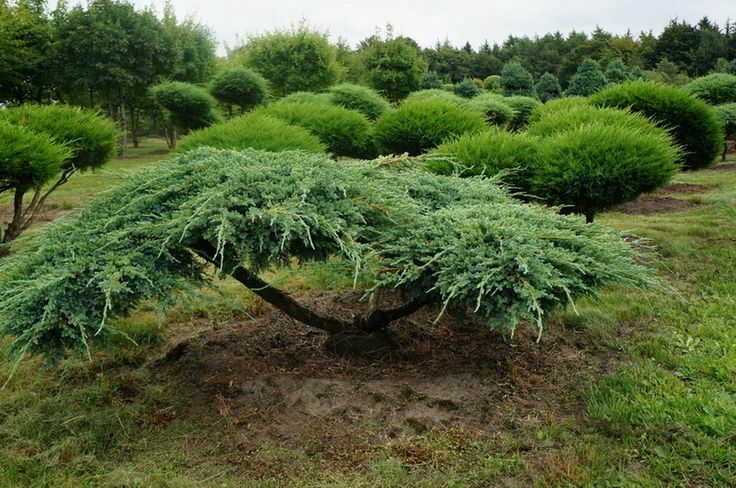
Cossack Juniper Garden Bonsai
Wind-bent tree (fukinagashi)
The main concept of the style is the struggle for existence. The trunk and branches grow in the dominant direction of the winds. Branches can grow across the entire diameter of the trunk, but the end result is that they all bend to one side. One side of the bonsai can be left without foliage. This creates the illusion that the composition is tilted by gusts of wind.
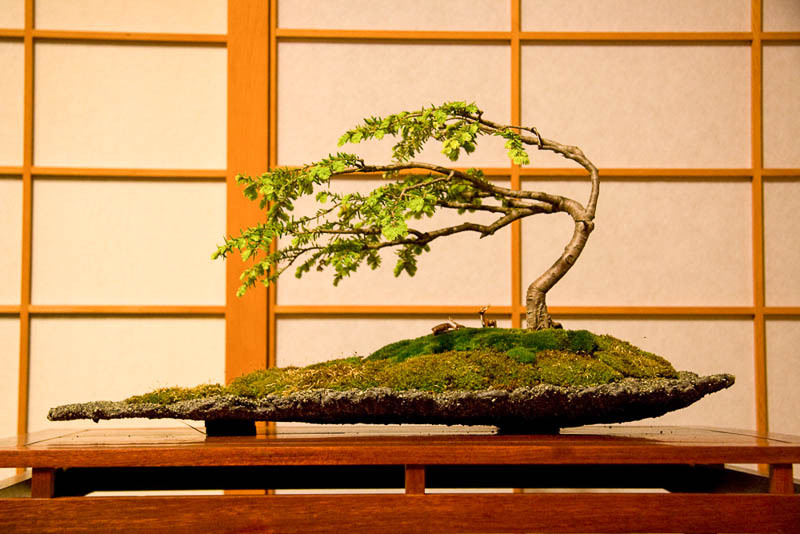
Fukinagashi is a tree with meanderingly inclined trunks
Dead wood style (sharimiki)
Styling assumes the formation of a composition that has been exposed to severe weather. A characteristic feature is the formation of bare areas without bark, starting from the base of the trunk and extending along its entire length. In artificial garden bonsai, this effect is achieved by removing the bark with a sharp knife. Subsequently, the exposed wood is processed with sulphurous lime.
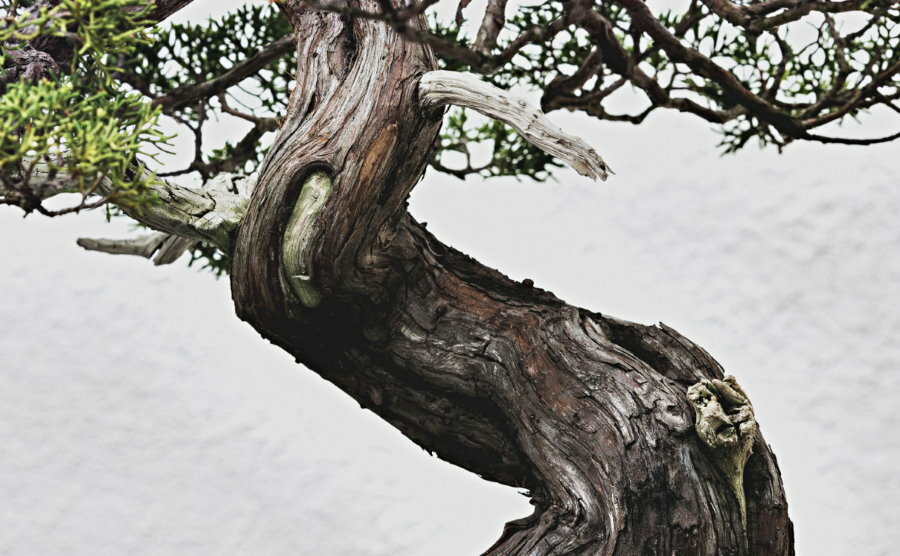
In the shaimiki style, the absence of bark on the tree is important, and the shape of the trunk itself does not really matter.
The list of styles is wide enough. Also distinguish the style Tree on a stone, Roots on a rock, Grove or group planting, Multi-stem, Double trunk, Literary, etc.
What plants can you make a bonsai
A characteristic feature of the Japanese garden is the pine trees, from which small ornamental Japanese trees are most often grown. The pine tree is capable of completely repeating the appearance of an adult breed and fits entirely in a small pot. Five-coniferous pines have different local and scientific names, but in general they are one species called small-flowered pine.
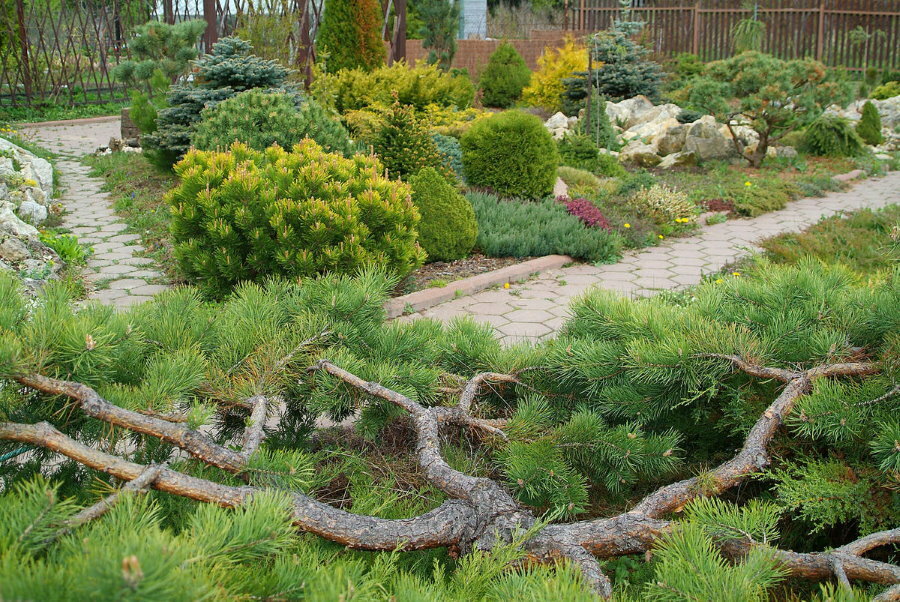
Conifers from the pine family easily enough the desired shape, just help them a little
White japanese pine
White Japanese pine bonsai is considered a unique species. It is evergreen, beautiful and prized for its light needles. The breed is represented by a conical or columnar tree with a spreading crown. The length of the needles ranges from 2 to 6 cm.
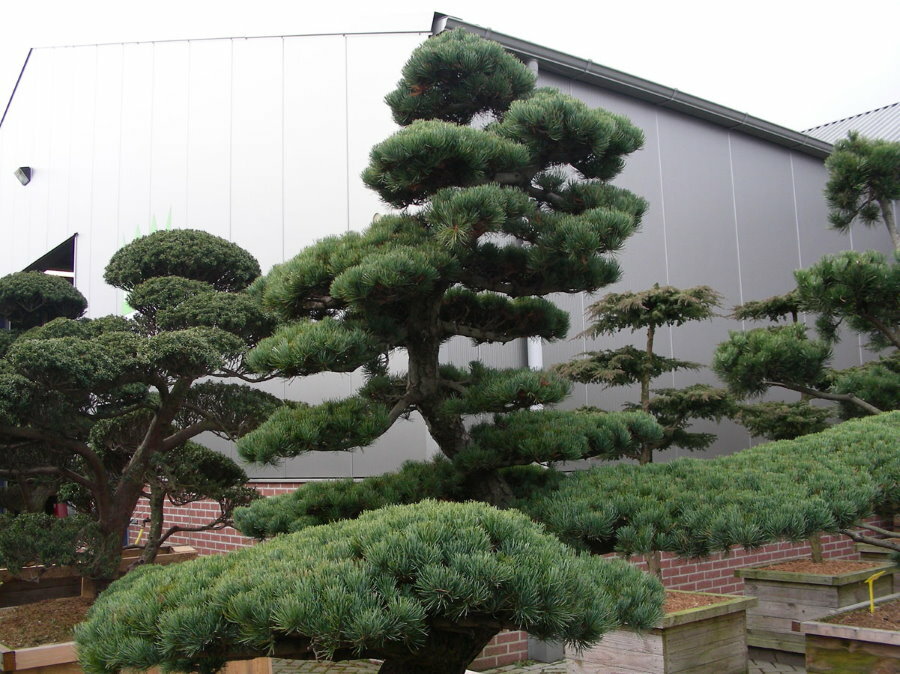
White Japanese pine is suitable for growing both in pots and outdoors
For full growth and maintenance of a decorative appearance, bonsai are planted in sunny places, since a lack of light leads to the death of branches. Also, the thick trunk and dense crown of this coniferous representative largely depends on good fertilization and proper care.
Scots pine
Scots pine garden bonsai is the most unpretentious type for growing Japanese ornamental tree species. The common pine is able to take any shape, keeping it well. She has paired needles, bluish or yellowish-green, 5-7 cm long. For healthy growth, you should first study what soil this type of tree prefers.
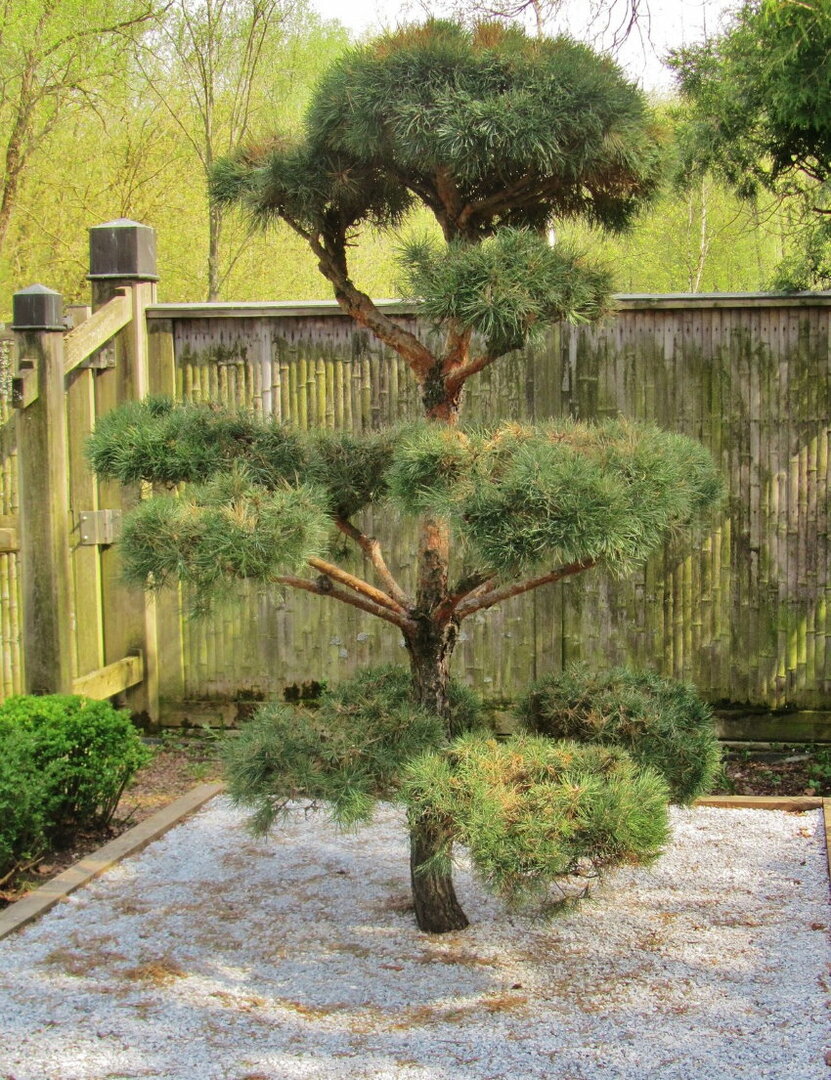
Scots pine is the most suitable material for creating bonsai in the middle lane
Mountain pine
Hardy, withstands any adverse weather conditions. Proper care provides dense, dense butchery and branches suitable for forming any crown style. Young seedlings grow crimson. As it grows up, it releases a pale purple inflorescence. Prefers spacious and bright places without drafts, as well as loamy and moist soils.
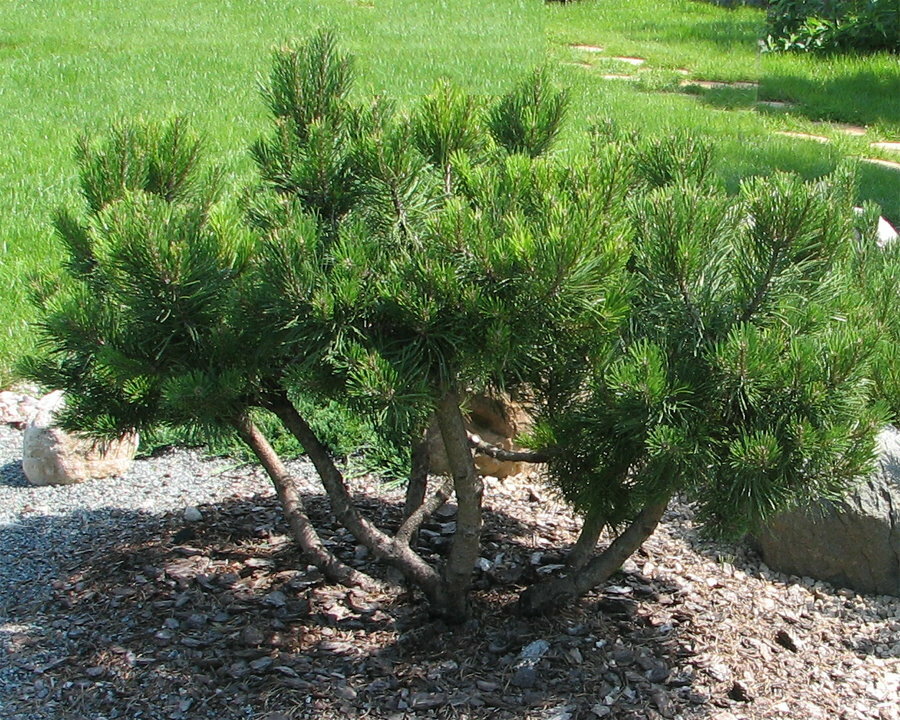
Mountain pine perfectly tolerates frosty winters
Black pine bonsai
It is valued for its lush crown, unpretentiousness, but it grows slowly and, with improper care, forms too long needles. Well suited for garden decoration, survives even with prolonged lack of nutrients. Over time, the bark acquires a purple-bright color, then cracks, resembling rock. Trees in Japan of this species are grown as a tribute to the ancient origins of oriental art.
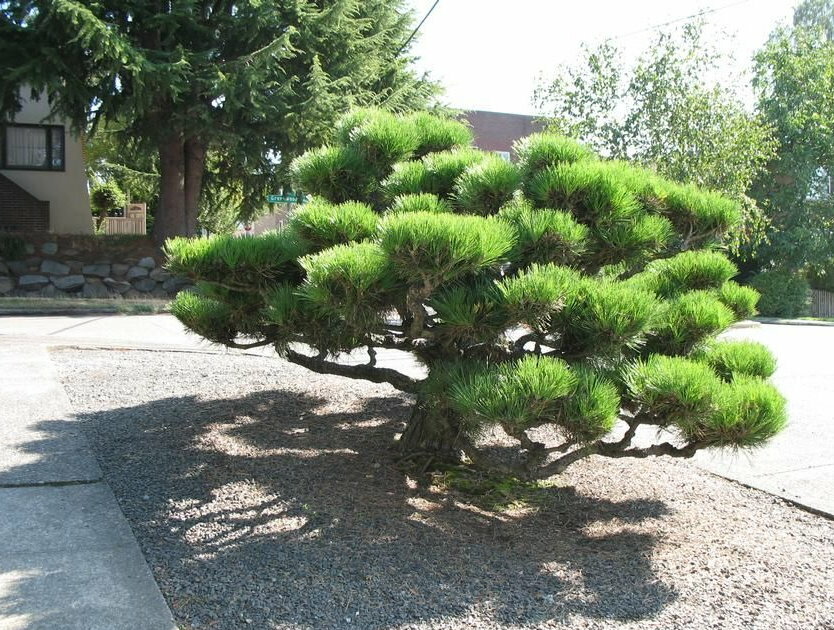
Black pine is great for growing in stony soils as a single formulation or with other plants on an alpine slide
Conclusion
Japanese bonsai in pots is quite common, but planted outdoors is still a rarity. Having studied the art of creating dwarf trees, you can grow original compositions that will become an undoubted decoration for a garden of any style.

